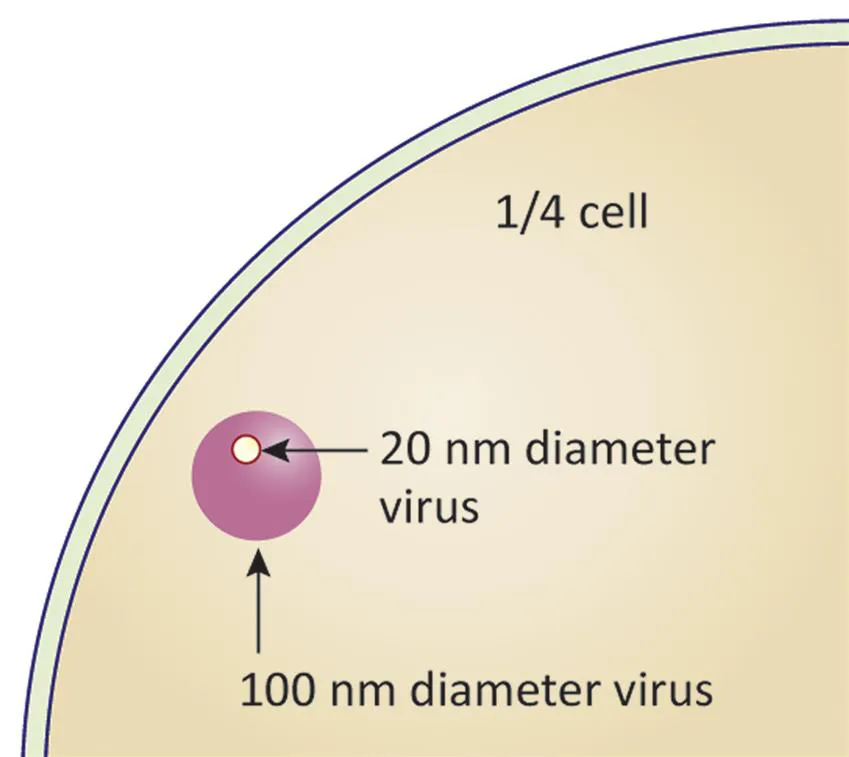
eBook - ePub
Viruses
From Understanding to Investigation
Susan Payne
This is a test
- 352 pages
- English
- ePUB (adapté aux mobiles)
- Disponible sur iOS et Android
eBook - ePub
Viruses
From Understanding to Investigation
Susan Payne
Détails du livre
Aperçu du livre
Table des matières
Citations
À propos de ce livre
Viruses: From Understanding to Investigation provides students with a map for lifetime learning by presenting the definition and unique characteristics of viruses, including major topics, such as the virus lifecycle, structure, taxonomy, evolution, history, host-virus interactions and methods to study viruses. In addition, the book assesses the connections between, and among, the aforementioned topics, providing an integrated approach and in-depth understanding of how viruses work.
- Employs a comparative strategy to emphasize unique structural and molecular characteristics that inform transmission, disease processes, vaccine strategies and host responses
- Presents a review of host cell and molecular biology and the immune system
- Features topical areas of research, including genomics in virus discovery, the virome, and beneficial interactions between viruses and their hosts
- Includes text boxes throughout with experimental approaches used by virologists
- Covers learning objectives for each chapter, methods and advances, question sets, quizzes and a glossary
Foire aux questions
Comment puis-je résilier mon abonnement ?
Il vous suffit de vous rendre dans la section compte dans paramètres et de cliquer sur « Résilier l’abonnement ». C’est aussi simple que cela ! Une fois que vous aurez résilié votre abonnement, il restera actif pour le reste de la période pour laquelle vous avez payé. Découvrez-en plus ici.
Puis-je / comment puis-je télécharger des livres ?
Pour le moment, tous nos livres en format ePub adaptés aux mobiles peuvent être téléchargés via l’application. La plupart de nos PDF sont également disponibles en téléchargement et les autres seront téléchargeables très prochainement. Découvrez-en plus ici.
Quelle est la différence entre les formules tarifaires ?
Les deux abonnements vous donnent un accès complet à la bibliothèque et à toutes les fonctionnalités de Perlego. Les seules différences sont les tarifs ainsi que la période d’abonnement : avec l’abonnement annuel, vous économiserez environ 30 % par rapport à 12 mois d’abonnement mensuel.
Qu’est-ce que Perlego ?
Nous sommes un service d’abonnement à des ouvrages universitaires en ligne, où vous pouvez accéder à toute une bibliothèque pour un prix inférieur à celui d’un seul livre par mois. Avec plus d’un million de livres sur plus de 1 000 sujets, nous avons ce qu’il vous faut ! Découvrez-en plus ici.
Prenez-vous en charge la synthèse vocale ?
Recherchez le symbole Écouter sur votre prochain livre pour voir si vous pouvez l’écouter. L’outil Écouter lit le texte à haute voix pour vous, en surlignant le passage qui est en cours de lecture. Vous pouvez le mettre sur pause, l’accélérer ou le ralentir. Découvrez-en plus ici.
Est-ce que Viruses est un PDF/ePUB en ligne ?
Oui, vous pouvez accéder à Viruses par Susan Payne en format PDF et/ou ePUB ainsi qu’à d’autres livres populaires dans Biological Sciences et Microbiology. Nous disposons de plus d’un million d’ouvrages à découvrir dans notre catalogue.
Informations
Sujet
Biological SciencesSous-sujet
MicrobiologyChapter 1
Introduction to Animal Viruses
Abstract
Viruses are infectious agents that are not cellular in nature. They consist of a nucleic acid genome packaged within a protein shell. Although relatively simple, viruses exhibit significant diversity in terms of size, genome organization, and capsid architecture. All viruses are obligate intracellular parasites as they must obtain energy and building blocks from the cell. They subvert many host cell processes for their own replication, and studying virus replication has provided detailed information about the basic workings of cells. At the cellular level, possible outcomes of infection range from production of virus particles without damage to the cell, to cell death, or occasionally cell transformation. In humans and animals the outcomes of infection range from inapparent (no disease) to considerable disease and death. Some viruses cause acute infections lasting for days or a few weeks while others infect their hosts for a lifetime. Viruses can evolve and rapidly adapt to changing conditions. Some viruses are easily replicated in cultured cells, while others require specific conditions only found in specialized cells within a human or animal. While this text focuses on viruses of humans and other animals, viruses infect organisms of all types, from bacteria to fungi to plants. Viruses are most often classified based on groups of genome and virion characteristics. Genome sequence comparisons provide an unbiased method for grouping and categorizing viruses.
Keywords
Virus; infectious agent; capsid; intracellular parasite; virion; host range; transmission; eclipse phase; one-step growth curve
After studying this chapter, you should be able to:
• Provide a meaningful definition of a virus.
• Explain difference between cell division and virus replication.
• Explain the correct usage of “virion” versus “virus.”
• Describe the basic steps in a virus replication-cycle.
• Draw, label, and describe each part of a “one-step” growth curve.
• List possible outcomes of a virus infection (1) at the level of the individual cell and (2) at the level of the host animal.
• Define the term “host range” as regards viruses.
What Is a Virus?
Most of us are familiar with the term virus and know viruses as disease causing agents, transmitted from one person or animal to another. We are familiar with “cold” and “flu” viruses; we fear a worldwide pandemic of Ebola. We may even be aware that viruses are used to deliver genes to cells for the purposes of gene therapy or genetic engineering. But what are viruses?
• Viruses are infectious agents that are not cellular in nature.
• Viruses must enter a living host cell in order to replicate, thus all viruses are obligate intracellular parasites. Synthesis of the proteins and nucleic acids (DNA and RNA) for assembly into new virus particles (virions) requires an energy source (ATP), building materials (amino acids and nucleotides), and protein synthesis machinery (ribosomes) supplied by the host cell. The cell also provides scaffolds (microtubules, filaments, membranes) on which virus particles replicate their genomes and assemble. Thus the cell is a factory providing working machinery and raw materials. The infected cell may or may not continue normal cellular processes (host cell mRNA and protein synthesis) during a viral infection.
• Viruses have nucleic acid genomes that are surrounded by and protected by protein coats called capsids. Capsids protect genomes from environmental hazards and are needed for efficient delivery of viral genomes into new host cells. Some viruses have lipid membranes, called envelopes that surround the capsid (Fig. 1.1).
• Viruses are structurally much simpler than cells. Some viruses can be crystalized. Viruses do not increase in number by cell division; instead they assemble from newly synthesized protein and nucleic acid parts (building blocks). As viruses are not cells, they have none the organelles associated with cells. A sample of purified virions has no metabolic activity.
• Viruses are packages designed to deliver nucleic acids to cells; they are excellent examples of “selfish genes.”

The preceding description might suggest uninteresting, inanimate particles, but examining virus replication strategies and interactions with host cells provides a diverse and dynamic view into cellular and molecular processes. Viruses are not a homogenous group. They are an extremely diverse group of infectious agents. It is highly unlikely that they arose from a single common ancestor (Box 1.1).
Diversity in the World of Viruses
• All viruses have nucleic acid genomes, but some utilize DNA as genetic material, while others have RNA genomes. Viral genomes are not always double-stranded molecules; there are single-stranded viral RNA and DNA genomes. There are viral genomes that consist of a single molecule of nucleic acid, but some genomes are segmented. For example, reoviruses (Chapter 26: Family Reoviridae) package 11–12 different pieces of double-stranded RNA and each genome segment encodes a different gene.
• Some viruses have lipid envelopes in addition to a genome and protein coat. Viral envelopes are not homogenous. Different types of host membranes may be utilized, and their specific lipid and protein components can differ.
• Viruses range in size from 10 to 1000 nm is size (Fig. 1.2).
• Viral genomes range in size from 3000 nucleotides (nt) to over 1,000,000 base pairs.
• Outcomes of viral infections are diverse. Infection does not always result in cell or host death. Some host genes are derived from viruses and have played key roles in evolution. (Some plant viruses are beneficial in extreme environments.)
• Some viruses complete their replication cycles in minutes while others take days. Some viruses are transiently associated with an infected host (days or weeks) while others (for example, herpesviruses) are life-long residents.
• Where did viruses come from? Three general scenarios for virus evolution have been proposed:
• Retrograde evolution: Intracellular parasites lost the ability for independent metabolism keeping only those genes necessary for replication. Poxviruses are very large complex viruses that may have evolved in this manner.
• Origins from cellular DNA and RNA components: Some DNA genomes resemble plasmids or episomes. Did these DNAs acquire protein coats and the ability to be transferred from cell to cell efficiently?
• Descendants of primitive precellular life forms: Viruses originated and evolved along with primitive, self-replicating molecules. This is the likeliest origin of the RNA viruses described in this text.

For the most part, names of specific viruses have been omitted in this section, to emphasize the general subject of viral diversity. Throughout this text, the details will be forthcoming. But I hope that now, when reading about any virus, you will want to learn its place in the complex world of viruses. (Big? small? friend? foe? transient visitor? life-long partner?)
Are Viruses Alive?
Viruses parasitize every known form of life on this planet and they have both short-term and long-term impacts on their hosts. But are viruses alive? This question is the subject of ongoing debate, but the answer does not change the nature of the virus. As we discuss and describe viruses it is easy to assume that they are alive. They replicate to increase in number and the terms “virus replication-cycle” and “virus life-cycle” are often used interchangeably. Viruses also evolve (change their genomes), sometimes very rapidly. In this manner they adapt to new hosts and environments.
In contrast, the virion (the physical package that we view with an electron microscope) has no met...